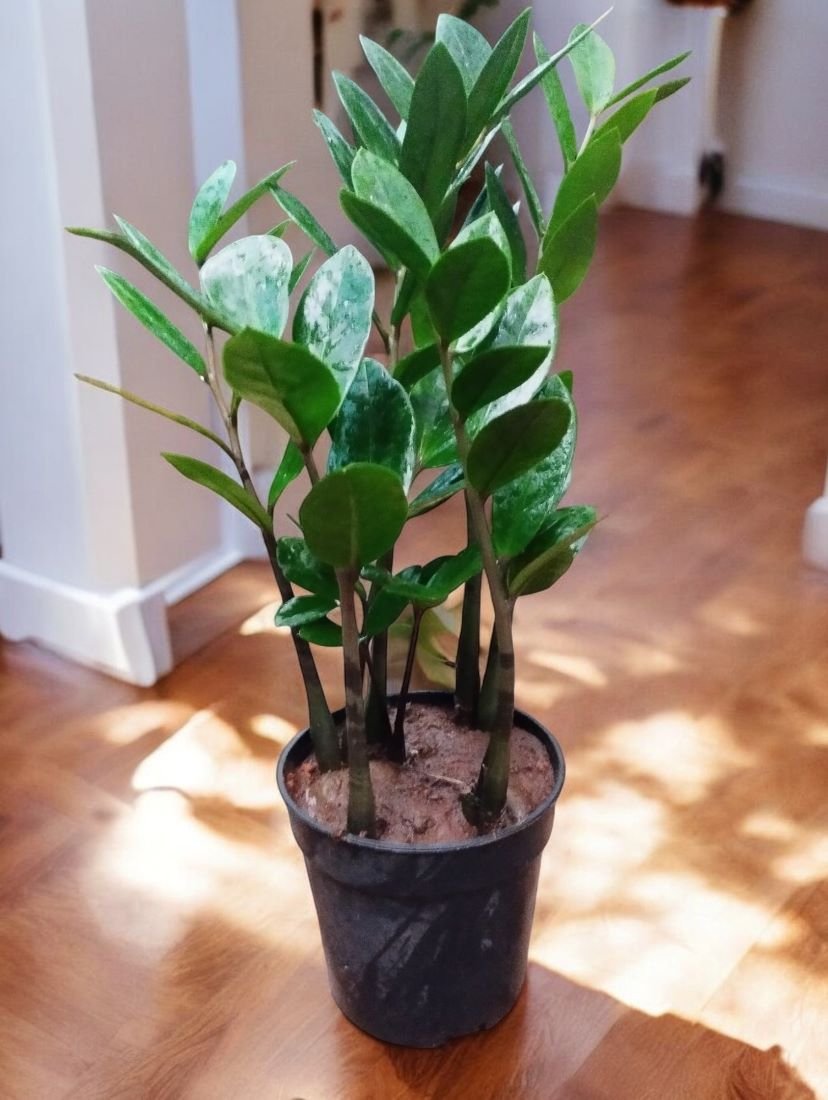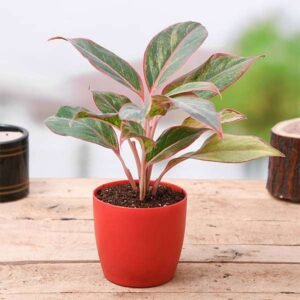Description
Green Zamia / ZZ Plant (Zamioculcas zamiifolia)
The Green Zamia, commonly known as the ZZ Plant and scientifically named Zamioculcas zamiifolia, is a popular houseplant prized for its glossy foliage, architectural shape, and remarkable resilience. Native to Eastern Africa, particularly regions like Zanzibar, Kenya, and Tanzania, the ZZ Plant has grown in popularity worldwide due to its minimal care requirements, aesthetic appeal, and adaptability to indoor environments.
Botanical Classification
- Kingdom: Plantae
- Clade: Angiosperms
- Order: Alismatales
- Family: Araceae
- Genus: Zamioculcas
- Species: Z. zamiifolia
Despite its name, the ZZ Plant is not a true Zamia (a genus of cycads), but rather a member of the Araceae family, which includes philodendrons, pothos, and peace lilies.
Physical Characteristics
1. Leaves
The ZZ Plant is best known for its attractive, waxy green leaves. The leaves grow in symmetrical, feather-like patterns along thick, upright stalks. Each stalk can bear 6 to 8 pairs of leaflets, which are ovate, shiny, and fleshy. Their glossy appearance gives them a nearly artificial, plastic-like quality, which makes them striking and modern in home décor.
The leaves’ vibrant green color contributes to their lush, tropical appearance. New growth may emerge as lighter green, gradually darkening as it matures. In some varieties, such as ‘Raven ZZ’, the leaves mature to a deep purple-black.
2. Stems and Rhizomes
What appears to be the stem of the ZZ Plant is actually a modified petiole, or leaf stalk. These emerge directly from underground rhizomes, which are thick, potato-like structures. Rhizomes store water and nutrients, enabling the plant to survive long periods of drought. This adaptation is one reason the ZZ Plant thrives on neglect.
3. Size
ZZ Plants are moderate growers. In ideal indoor conditions, they can grow up to 2 to 4 feet (60–120 cm) in height, with a similar spread. Their upright, tidy growth habit makes them suitable for tabletops, corners, or floor containers.
Growth Habit and Care
1. Light Requirements
The ZZ Plant is extremely tolerant of varying light levels, making it perfect for low-light environments like offices or shaded rooms. While it can survive in low light, it grows more vigorously and maintains better coloration in bright, indirect light. Direct sunlight, especially intense afternoon sun, can scorch the leaves.
2. Watering
One of the standout traits of the ZZ Plant is its drought tolerance. Thanks to its rhizomes, it can go weeks without water. Overwatering is a more common issue than underwatering. It’s best to let the soil dry out completely between waterings. Yellowing leaves are often a sign of excessive moisture or root rot.
3. Soil
ZZ Plants prefer well-draining soil, such as a cactus or succulent mix. Adding perlite or sand can help improve aeration and prevent waterlogging.
4. Temperature and Humidity
These plants thrive in typical indoor temperatures (65–75°F or 18–24°C). They are not frost-tolerant and should be kept away from cold drafts. While they tolerate low humidity, they appreciate occasional misting in drier environments.
5. Fertilization
During the growing season (spring and summer), a balanced liquid fertilizer diluted to half strength once a month is sufficient. Over-fertilization can lead to salt buildup and damage the roots.
Propagation
ZZ Plants can be propagated through leaf cuttings, stem cuttings, or division of rhizomes. Leaf propagation is slow and may take months to produce roots and rhizomes. Dividing rhizomes is the fastest and most reliable method, especially for mature plants.
Common Problems
- Yellow Leaves: Often due to overwatering or poor drainage.
- Brown Leaf Tips: Can indicate dry air, salt buildup, or underwatering.
- Leggy Growth: Usually a result of insufficient light.
- Pests: ZZ Plants are relatively pest-resistant but can occasionally suffer from aphids, spider mites, or mealybugs.
Toxicity
The ZZ Plant is toxic to pets and humans if ingested. It contains calcium oxalate crystals, which can cause irritation, nausea, or vomiting when chewed or eaten. Handling the plant may also cause skin irritation in sensitive individuals, so wearing gloves is advisable during pruning or repotting.
Despite past rumors, the ZZ Plant is not carcinogenic, but caution should still be exercised around pets and children.
Air Purification
According to a NASA Clean Air Study, the ZZ Plant has air-purifying qualities. It can help remove toxins such as xylene, toluene, and benzene from the air. Although the purifying effect is minimal compared to industrial standards, it still contributes to a cleaner indoor atmosphere.
Symbolism and Feng Shui
In Feng Shui, the ZZ Plant is associated with prosperity, growth, and positive energy. Its upright stems are thought to represent steady progress and stability, making it a favorite in offices and workspaces. It is often referred to as the “fortune plant” or “eternity plant,” symbolizing resilience and long life.
Popular Varieties
- Zamioculcas zamiifolia ‘Raven’ – This variety starts with bright green foliage that darkens to a dramatic purple-black as it matures.
- Zamioculcas zamiifolia ‘Zenzi’ – A dwarf variety with a compact growth habit and curled leaves.
- Variegated ZZ Plant – Rare and more expensive, featuring cream or yellow variegation on the leaves.
Design and Decor Uses
The ZZ Plant’s sculptural, modern aesthetic makes it ideal for minimalist, contemporary, and even bohemian interiors. It works well in decorative pots and planters and can elevate spaces such as:
- Living rooms
- Bathrooms
- Bedrooms
- Office desks
- Hotel lobbies
- Waiting areas
Because it tolerates low light and irregular watering, it’s also a go-to plant for beginner gardeners and frequent travelers.
Environmental Benefits
Beyond aesthetics and air purification, the ZZ Plant offers several benefits:
- Noise Dampening: Dense foliage helps slightly reduce noise in enclosed spaces.
- Stress Reduction: Greenery has been shown to improve mood, focus, and reduce stress levels in indoor environments.
- Humidity Control: While minor, the plant contributes to indoor humidity through transpiration.
Final Thoughts
The ZZ Plant (Zamioculcas zamiifolia) stands out as a perfect blend of form and function. It is almost indestructible, thrives in various lighting conditions, and requires minimal maintenance, making it ideal for both seasoned plant collectors and beginners. Whether placed in a corporate office or a cozy home corner, its striking form and lush foliage bring a touch of natural beauty and tranquility to any space.






 MONEY PLANT GREEN-PLANT
MONEY PLANT GREEN-PLANT  PENCIL PINE -PLANT
PENCIL PINE -PLANT 

Reviews
There are no reviews yet.